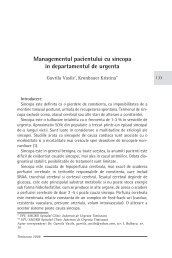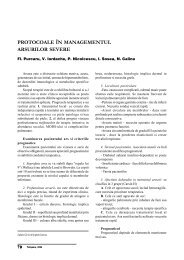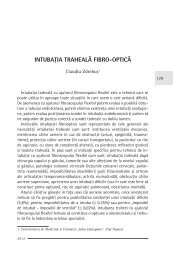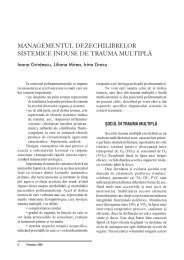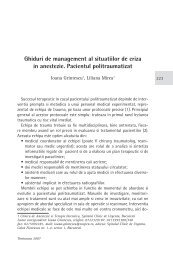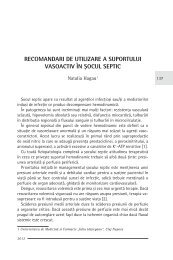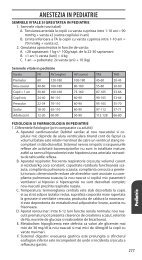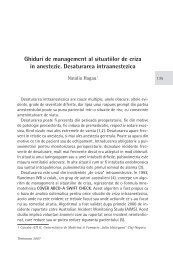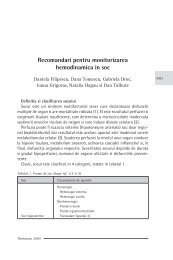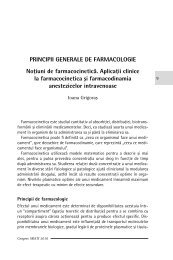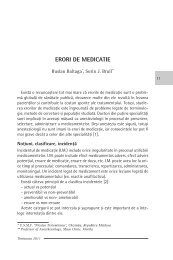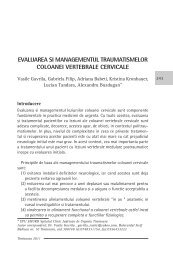Algoritm de diagnostic si tratament in infectiile fungice in
Algoritm de diagnostic si tratament in infectiile fungice in
Algoritm de diagnostic si tratament in infectiile fungice in
You also want an ePaper? Increase the reach of your titles
YUMPU automatically turns print PDFs into web optimized ePapers that Google loves.
mented to have returned to safe local limits before<br />
removal.<br />
Direct Thromb<strong>in</strong>-<strong>in</strong>hibitors<br />
Hirud<strong>in</strong> and (Xi)melagatran<br />
Hirud<strong>in</strong>s directly <strong>in</strong>hibits free and bound thromb<strong>in</strong>.<br />
These compounds are anticoagulants that were<br />
orig<strong>in</strong>ally extracted from leeches and now are commercially<br />
available as the recomb<strong>in</strong>ant lepirud<strong>in</strong>e<br />
(Refludan ® ). Melagatran and its prodrug ximelagatran<br />
are synthetic compounds that are not commercially<br />
available yet. The elim<strong>in</strong>ation half-lives of lepirud<strong>in</strong>e<br />
(i.v.), melagatran (s.c.) and ximelagatran (p.o.) are 2<br />
– 3 h, 2 – 3 h and 4 – 5 h, respectively. Half-lives will<br />
be longer <strong>in</strong> the presence of renal <strong>in</strong>sufficiency. The<br />
anticoagulant effect can be quantified u<strong>si</strong>ng the aPTT.<br />
Up to date there are <strong>in</strong>sufficient data to make<br />
any recommendations concern<strong>in</strong>g the use of major<br />
nerve block<strong>in</strong>g techniques <strong>in</strong> patients treated with<br />
lepirud<strong>in</strong>e or (xi)melagatran. Based on the pharmacological<br />
profile of these compounds epidural and /or<br />
sp<strong>in</strong>al needle/catheters <strong>in</strong>sertion or catheter removal<br />
should only be performed when these drugs are no<br />
longer active: at least 8–10 h after last dose of these<br />
drugs and 2–4 h prior to the next adm<strong>in</strong>istration.<br />
WHAT ABOUT PERIPHERAL NERVE<br />
BLOCKS ?<br />
We have focused for this on the French gui<strong>de</strong>l<strong>in</strong>es<br />
as there is a lack on literature regard<strong>in</strong>g pos<strong>si</strong>ble<br />
complications of peripheral blocks un<strong>de</strong>r anticoagulated<br />
conditions. Major problems are rare while there<br />
are several reasons for this. Some blocks are superficial<br />
and a bleed<strong>in</strong>g will be <strong>de</strong>tected rather fast while<br />
compres<strong>si</strong>on is po<strong>si</strong>ble. In the most problematic case<br />
a surgical <strong>in</strong>tervention for <strong>de</strong>compres<strong>si</strong>on may be<br />
necessary. In several blocks the distance between<br />
the nerve and the blood vessel is at least 1cm but<br />
when <strong>in</strong> case of bleed<strong>in</strong>g most of the time a rather<br />
large vessel is <strong>in</strong>volved. The long duration of the block<br />
may make the differential diagno<strong>si</strong>s with nerve compres<strong>si</strong>on<br />
troublesome. Of course therapeutic anticoagulation<br />
preclu<strong>de</strong>s peripheral nerve blocks. In bor<strong>de</strong>rl<strong>in</strong>e<br />
conditions the placement of a catheter should<br />
be questioned.<br />
REFERENCES<br />
1. Anonymous. Belgian gui<strong>de</strong>l<strong>in</strong>es concern<strong>in</strong>g drug <strong>in</strong>duced alteration<br />
of coagulation and central neuraxial anesthe<strong>si</strong>a. Acta<br />
Anaesthe<strong>si</strong>ologica Belgica 2000;51:101-4.<br />
2. Raskob GE, Hirsh J. Controver<strong>si</strong>es <strong>in</strong> tim<strong>in</strong>g of the first dose of<br />
anticoagulant prophylaxis aga<strong>in</strong>st venous thromboembolism<br />
after major orthopedic surgery. Chest 2003; 124:379S-85S.<br />
3. Zufferey P, Laporte S, Quenet S et al. Optimal LMWH regimen<br />
<strong>in</strong> major orthopaedic surgery. A meta-analy<strong>si</strong>s of randomised<br />
trials. Thromb Haemost 2003; 90:654-61.<br />
4. Hull RD, P<strong>in</strong>eo GF, Ste<strong>in</strong> PD et al. Tim<strong>in</strong>g of <strong>in</strong>itial adm<strong>in</strong>istration<br />
of low-molecular-weight hepar<strong>in</strong> prophylaxis aga<strong>in</strong>st <strong>de</strong>ep<br />
ve<strong>in</strong> thrombo<strong>si</strong>s <strong>in</strong> patients follow<strong>in</strong>g elective hip arthroplasty:<br />
a systematic review. Arch Intern Med 2001;161:1952-60.<br />
5. Kwong LM, Muntz JE. Thromboprophylaxis do<strong>si</strong>ng: the<br />
relationship between tim<strong>in</strong>g of first adm<strong>in</strong>istration, efficacy,<br />
and safety. Am J Orthop 2002; 31:16-20.<br />
6. Kehlet H, Holte K. Effect of postoperative analge<strong>si</strong>a on surgical<br />
outcome. Br J Anaesth 2001; 87:62-72.<br />
7. Rodgers A, Walker N, Schug S et al. Reduction of postoperative<br />
mortality and morbidity with epidural or sp<strong>in</strong>al anaesthe<strong>si</strong>a:<br />
results from overview of randomised trials. BMJ 2000;<br />
321:1493.<br />
8. Modig J, Borg T, Karlström G, al e. Thromboembolism after<br />
total hip replacement: Role of epidural and general anesthe<strong>si</strong>a.<br />
Anesthe<strong>si</strong>a and Analge<strong>si</strong>a 1983; 62:174-8.<br />
9. Pr<strong>in</strong>s MH, Hirsh J. A comparison of general anesthe<strong>si</strong>a and<br />
regional anesthe<strong>si</strong>a as a risk factor for <strong>de</strong>ep ve<strong>in</strong> thrombo<strong>si</strong>s<br />
follow<strong>in</strong>g hip surgery: a critical review. Thrombo<strong>si</strong>s and<br />
Haemosta<strong>si</strong>s 1990; 64:497-500.<br />
10. Van<strong>de</strong>rmeulen EP, Van Aken H, Vermylen J. Anticoagulants<br />
and sp<strong>in</strong>al-epidural anesthe<strong>si</strong>a. Anesthe<strong>si</strong>a & Analge<strong>si</strong>a 1994;<br />
79:1165-77.<br />
11. Horlocker TT, We<strong>de</strong>l DJ. Neurologic complications of sp<strong>in</strong>al and<br />
epidural anesthe<strong>si</strong>a. Reg Anesth Pa<strong>in</strong> Med 2000;25:83-98.<br />
12. Schroe<strong>de</strong>r DR. Statistics: <strong>de</strong>tect<strong>in</strong>g a rare adverse drug reaction<br />
u<strong>si</strong>ng spontaneous reports. Reg Anesth Pa<strong>in</strong> Med 1998; 23:183-<br />
9.<br />
13. Lawton MT, Porter RW, Heiserman JE et al. Surgical<br />
management of sp<strong>in</strong>al epidural hematoma: relationship<br />
between surgical tim<strong>in</strong>g and neurological outcome. J Neurosurg<br />
1995; 83:1-7.<br />
14. Boneu B, Necciari J, Cariou R et al. Pharmacok<strong>in</strong>etics and<br />
tolerance of the natural pentasacchari<strong>de</strong> (SR90107/Org31540)<br />
with high aff<strong>in</strong>ity to antithromb<strong>in</strong> III <strong>in</strong> man. Thromb<br />
Haemost 1995; 74:1468-73.<br />
15. Sanofi-Synthelabo. The EXPERT Study: Evaluation of AriXtra<br />
for the Prevention of VEnous ThRomboembolism <strong>in</strong> daily<br />
PracTice. 2004, In Progress.<br />
16. Leese PT, Hubbard RC, Karim A et al. Effects of celecoxib, a<br />
novel cyclooxygenase-2 <strong>in</strong>hibitor, on platelet function <strong>in</strong><br />
healthy adults: a randomized, controlled trial. J Cl<strong>in</strong> Pharmacol<br />
2000; 40:124-32.<br />
Actualit\]i




